Daisuke Goto – The first to cultivate mushrooms in Samoa
For my winter vacation and to escape the cold of Ithaca, I visited my mother in Samoa. She is a pharmacist who is doing volunteer work there through an organization called Japan International Cooperation Agency (JICA). JICA is analogous to the American Peace Corps — they send volunteers to less developed countries to help with economic and social development (JICA, 1995).
 Samoa (formally The Independent State of Samoa) is located in the South Pacific just east of the International Date Line and north of New Zealand. The country comprises two main islands and eight smaller islands with a total land area of 2934 km2 and a population of approximately 180,000. Samoa was, famously, the adopted home of Robert Louis Stevenson, author of Treasure Island and other novels. (Map courtesy of the Samoa Tourism Authority, 2005).
Samoa (formally The Independent State of Samoa) is located in the South Pacific just east of the International Date Line and north of New Zealand. The country comprises two main islands and eight smaller islands with a total land area of 2934 km2 and a population of approximately 180,000. Samoa was, famously, the adopted home of Robert Louis Stevenson, author of Treasure Island and other novels. (Map courtesy of the Samoa Tourism Authority, 2005).
Before I got there, my mother had told me of a man who had come to Samoa to develop mushroom cultivation as a means of generating local income. Since I am interested in mushrooms, the idea sounded interesting, and I asked her to arrange a meeting with the volunteer during my stay. The volunteer, Daisuke Goto, was very kind to take me on a tour of his facilities on Upolu and tell me about his project.

The project was initiated by the Chinese government in 1999, but as they failed to produce mushrooms, JICA came to the rescue and has been involved since 2001. The first JICA volunteer was also unable to produce mushrooms, but Daisuke, who came next, has succeeded in producing the first cultivated mushrooms in Samoa. Daisuke says, “This has taken way too long!” Daisuke’s goal in Samoa is to establish a mushroom cultivation protocol and to transmit mushroom-growing skills to local farmers.
It turns out that growing mushrooms in Samoa is not as easy as you might think. The hot tropical climate is hard on mushrooms, and few conventional substrates are available locally. Farmers lack elaborate laboratory facilities with cooled growth chambers, and grain and hardwoods generally used for mushroom cultivation are not grown in Samoa. Daisuke has overcome these obstacles with his creative ideas. Rather than cultivating the common oyster mushroom, Pleurotus ostreatus, he uses P. pulmonarius, an oyster mushroom more tolerant of higher temperatures. Other species he has had success with are Auricularia polytricha (wood ear mushroom), Ganoderma lucidum (reishi), and Pleurotus citrinopileatus (golden oyster mushroom). The Auricularia and Ganoderma strains he is using were found in the native forests of Samoa, and other cultures have been sent from Japan. Daisuke has also experimented with Lentinula edodes (shiitake), however, he has found that the climate and available substrates limit its production.
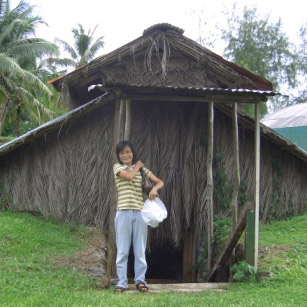 Daisuke’s predecessor dug out a big hole and built an underground hut with the idea that mushrooms might grow better where it is cooler. At right is Mana’s mother with the mushroom hut. Unfortunately, Daisuke has found that there is not enough light in the hut for fruiting and some watering is required. He still has some ongoing experiments in there using Auricularia and Pleurotus when there is too much rain outside.
Daisuke’s predecessor dug out a big hole and built an underground hut with the idea that mushrooms might grow better where it is cooler. At right is Mana’s mother with the mushroom hut. Unfortunately, Daisuke has found that there is not enough light in the hut for fruiting and some watering is required. He still has some ongoing experiments in there using Auricularia and Pleurotus when there is too much rain outside.
Spawn is typically made from inoculated grain, but grain is not produced on Samoa, so Daisuke uses sawdust from a native broadleaf lumber tree, the Kava tree. In case anybody is confused, this is not the same Kava (Piper methysticum) that people make into mind-altering drinks! He also tried using coconut meat pressings, but says the sweet smell attracts mice and cockroaches, so he has had to stop using it. Kava sawdust works well for generating spawn but results in poor fruiting when used as substrate material. Therefore, for the fruiting substrate, Daisuke has come up with an interesting recipe that calls for mowed weeds and beer waste at an 8:1 ratio. Weeds are abundant everywhere and Samoans have a large beer industry relative to the size of their country (a legacy of German colonization). Thus, these materials are easily accessible and, better yet, free. You may wonder where the barley for beer comes from–in fact, it is imported. The substrate is packed in autoclavable bags with filter patches and sterilized in a pressure cooker, because large autoclaves are not available. Then, a hole is made in the middle of the substrate and inoculated with the spawn. Spawn production and spawn run takes place indoors, but fruiting takes place outdoors. Daisuke takes the colonized substrate bags out under the trees and makes good use of the highly humid climate and natural shade for fruiting. He said the mushrooms fruit better outdoors—the only problem is that now he is in competition with the slugs.
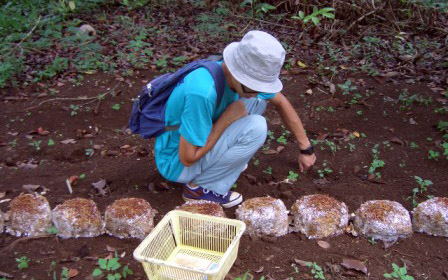
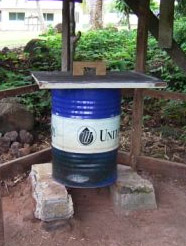 In this way, Daisuke has established a standard protocol that the local people can follow to cultivate mushrooms. His next step is to scale up the production and teach the farmers how to do it. One problem he faces is the inability to mass sterilize using the pressure cooker and the high costs of the autoclavable bags. He is currently experimenting with using a large oil drum to boil and pasteurize the fruiting substrate.
In this way, Daisuke has established a standard protocol that the local people can follow to cultivate mushrooms. His next step is to scale up the production and teach the farmers how to do it. One problem he faces is the inability to mass sterilize using the pressure cooker and the high costs of the autoclavable bags. He is currently experimenting with using a large oil drum to boil and pasteurize the fruiting substrate.
The word for mushroom in Samoan is “pulou aitu” where “pulou” means “hat” and “aitu” means “ghost.” Despite the mycophobic sound of the word, Daisuke says that the local people are optimistic about accepting mushrooms as a new food source. With Daisuke’s perseverance, the project looks promising and will be interesting to follow up on. I could go on bragging about the beautiful snorkeling and diving Samoa had to offer as well, but I guess I will stop here, because my vacation is complete as long as I see mushrooms!
Acknowledgment
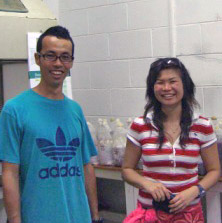 I am very grateful to Daisuke Goto for his time and effort to show me around the facilities and tell me about his project. In addition, his frequent correspondence has been very helpful in answering the many questions that kept arising as I wrote this post.
I am very grateful to Daisuke Goto for his time and effort to show me around the facilities and tell me about his project. In addition, his frequent correspondence has been very helpful in answering the many questions that kept arising as I wrote this post.


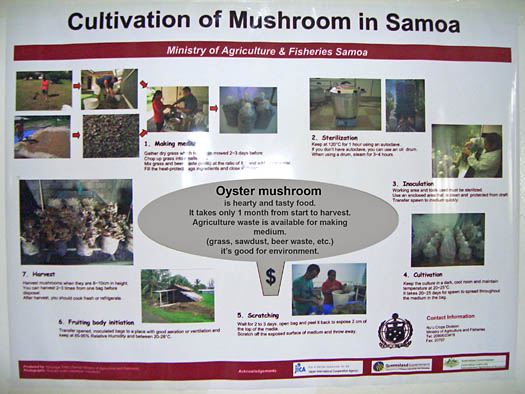
What a delightful story! It combines the attraction of a fascinating remote island paradise with a good mushroom story. What could be better? Thanks for sharing it with us.
heh i develop website about african and asian art objects – and i would like to ask you to show something else about those countries than just how they can grow mushrooms – show about their art and how they use mushrooms in their art styles?
except for barley, what’s other suitable grains which can make mother spawn? thank you….
Hey there Tan,
You can use mostly all cereal grains for spawn production. I use rye berries, but wheat berries are also very commonly used. Wild Bird Seed which is a mixture of grains is used by many people in the US. Millet is also popular, but hard to get appropriate moisture content. If you have more mushroom questions, please feel free to e-mail me at jeremy82many at hotmail dot com.
HI
By accident i have read your delightful blog. it was very useful.and will be very kind of you if you show me how to cultivate mushroom in doors in mass production.
thank you …my best wishs
Hi,
What a great story. I have always been admiring people like Deisuke Goto. I wonder how does he make it now since this is now 2010. I am a beginner of mushroom lover and since July 2009 studying on spawning in lab, learning how to cultivate it now as my next level. Still in the learning step and long ways to go. I wish one day my knowledge can be useful like Deisuke’s.
Regards,